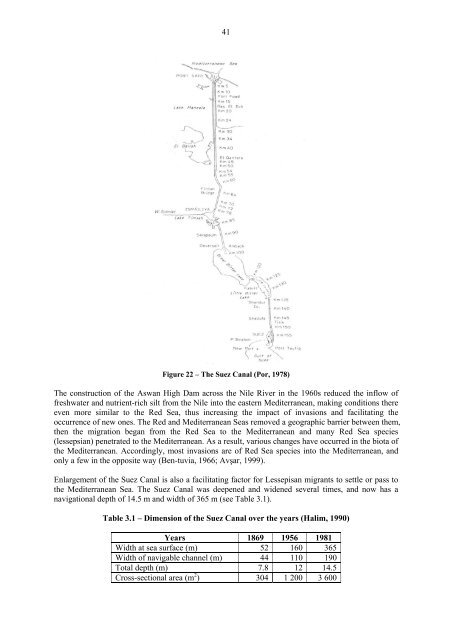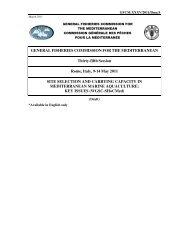Status of alien species in the Mediterranean and Black Sea
Status of alien species in the Mediterranean and Black Sea
Status of alien species in the Mediterranean and Black Sea
You also want an ePaper? Increase the reach of your titles
YUMPU automatically turns print PDFs into web optimized ePapers that Google loves.
41<br />
Figure 22 – The Suez Canal (Por, 1978)<br />
The construction <strong>of</strong> <strong>the</strong> Aswan High Dam across <strong>the</strong> Nile River <strong>in</strong> <strong>the</strong> 1960s reduced <strong>the</strong> <strong>in</strong>flow <strong>of</strong><br />
freshwater <strong>and</strong> nutrient-rich silt from <strong>the</strong> Nile <strong>in</strong>to <strong>the</strong> eastern <strong>Mediterranean</strong>, mak<strong>in</strong>g conditions <strong>the</strong>re<br />
even more similar to <strong>the</strong> Red <strong>Sea</strong>, thus <strong>in</strong>creas<strong>in</strong>g <strong>the</strong> impact <strong>of</strong> <strong>in</strong>vasions <strong>and</strong> facilitat<strong>in</strong>g <strong>the</strong><br />
occurrence <strong>of</strong> new ones. The Red <strong>and</strong> <strong>Mediterranean</strong> <strong>Sea</strong>s removed a geographic barrier between <strong>the</strong>m,<br />
<strong>the</strong>n <strong>the</strong> migration began from <strong>the</strong> Red <strong>Sea</strong> to <strong>the</strong> <strong>Mediterranean</strong> <strong>and</strong> many Red <strong>Sea</strong> <strong>species</strong><br />
(lessepsian) penetrated to <strong>the</strong> <strong>Mediterranean</strong>. As a result, various changes have occurred <strong>in</strong> <strong>the</strong> biota <strong>of</strong><br />
<strong>the</strong> <strong>Mediterranean</strong>. Accord<strong>in</strong>gly, most <strong>in</strong>vasions are <strong>of</strong> Red <strong>Sea</strong> <strong>species</strong> <strong>in</strong>to <strong>the</strong> <strong>Mediterranean</strong>, <strong>and</strong><br />
only a few <strong>in</strong> <strong>the</strong> opposite way (Ben-tuvia, 1966; Avşar, 1999).<br />
Enlargement <strong>of</strong> <strong>the</strong> Suez Canal is also a facilitat<strong>in</strong>g factor for Lessepisan migrants to settle or pass to<br />
<strong>the</strong> <strong>Mediterranean</strong> <strong>Sea</strong>. The Suez Canal was deepened <strong>and</strong> widened several times, <strong>and</strong> now has a<br />
navigational depth <strong>of</strong> 14.5 m <strong>and</strong> width <strong>of</strong> 365 m (see Table 3.1).<br />
Table 3.1 – Dimension <strong>of</strong> <strong>the</strong> Suez Canal over <strong>the</strong> years (Halim, 1990)<br />
Years 1869 1956 1981<br />
Width at sea surface (m) 52 160 365<br />
Width <strong>of</strong> navigable channel (m) 44 110 190<br />
Total depth (m) 7.8 12 14.5<br />
Cross-sectional area (m 2 ) 304 1 200 3 600
















